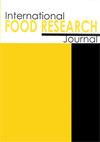凝固剂类型和浓度对胡麻籽豆腐的物理化学、质地和微观结构特性的影响
IF 0.7
4区 农林科学
Q4 FOOD SCIENCE & TECHNOLOGY
引用次数: 0
摘要
研究了凝固剂的类型和浓度对豆腐的物理化学、质地和微观结构特性的影响。使用的凝固剂有葡萄糖酸δ-内酯(GDL)、CH3COOH、氯化镁和 CaSO4,浓度分别为 0.25、0.5、0.75 和 1.0 g%(w/v)。从 65°C 下浸泡 2 小时 40 分钟的种子中提取 Kenaf 种子乳状提取物,并按 1:6 的种子与水比例进行研磨。提取的乳状提取物在 95°C 的温度下蒸煮 3 分钟,冷却至 80°C,然后用适当浓度的凝结剂凝结。对豆腐的产量、理化指标、质地和微观结构进行了检测。结果表明,豆腐的产量和水分含量受凝固剂类型和浓度的影响不大。凝固剂类型会影响豆腐的粗蛋白、粗脂肪和表面颜色。GDL凝固豆腐的粗蛋白含量(35.09 - 39.07 克/100 克)明显较高,而氯化镁凝固豆腐的粗脂肪含量(59.64 - 63.15 克/100 克)明显较高。豆腐的硬度、咀嚼性和回弹性受凝固剂类型和浓度的影响。CH3COOH凝固豆腐的硬度明显较高(2490.1 - 4005.8 克),而氯化镁凝固豆腐的硬度明显较低(814.45 - 2009.9 克)。所有豆腐的扫描电子显微镜都显示,除了用 0.25 g%(重量/体积)凝结的豆腐外,其他豆腐的结构都比较粗糙,蛋白质聚集得比较密集,并有较大的孔隙,而用 0.25 g%(重量/体积)凝结的豆腐则显示出一种由紧密的网状结构组成的假蜂蜜状结构。结论是,所有 0.25 g%(w/v)的凝固剂都适用于生产铁观音籽豆腐。本文章由计算机程序翻译,如有差异,请以英文原文为准。
Physicochemical, textural, and microstructural properties of kenaf (Hibiscus cannabinus L.) seed tofu as affected by coagulant types and concentrations
Hard tofu was developed from kenaf seed, and the effects of coagulant types and concentrations on the physicochemical, textural, and microstructural properties of the tofu were studied. Glucono delta-lactone (GDL), CH3COOH, MgCl2, and CaSO4 were the coagulants used at concentrations of 0.25, 0.5, 0.75, and 1.0 g% (w/v). Kenaf seed milky extract was obtained from the seed soaked at 65°C for 2 h 40 min, and ground using 1:6 seed-to-water ratio. The extracted milky extract was cooked to 95°C for 3 min, cooled to 80°C, and then coagulated with appropriate coagulant concentration. The yield, physicochemical, texture, and microstructure of the tofu were examined. The results indicated that the yield and moisture content of the tofu were not significantly affected by coagulant types and concentrations. Coagulant types affected the crude protein, crude fat, and surface colour of the tofu. GDL-coagulated tofu had significantly higher crude protein (35.09 - 39.07 g/100 g), while MgCl2-coagulated tofu had significantly higher crude fat (59.64 - 63.15 g/100 g). The hardness, chewiness, and springiness of the tofu were affected by the coagulant types and concentrations. CH3COOH-coagulated tofu had significantly higher hardness (2490.1 - 4005.8 g), while MgCl2-coagulated tofu had significantly lower hardness (814.45 - 2009.9 g). Scanning electron microscopy of all the tofu showed a rough-like structure of denser aggregated proteins with large pores, except for the tofu made with 0.25 g% (w/v) which exhibited a pseudo-honey-like structure of compacted network strands. It was concluded that all the coagulants at 0.25 g% (w/v) were suitable to produce kenaf seed tofu.
求助全文
通过发布文献求助,成功后即可免费获取论文全文。
去求助
来源期刊

international food research journal
Agricultural and Biological Sciences-Food Science
CiteScore
1.40
自引率
0.00%
发文量
75
期刊介绍:
The International Food Research Journal (IFRJ) publishes papers in English, six (6) issues a year with the coverage of:
Food Science and Technology
Nutrition and Dietetics
Agriculture, multidisciplinary
Chemistry, multidisciplinary
The scope of the Journal includes:
Food Science, Food Technology and Food Biotechnology
Product Development and Sensory Evaluation
Food Habits, Nutrition, and Health
Food Safety and Quality
Food Chemistry, Food Microbiology, Food Analysis and Testing
Food Engineering
Food Packaging
Food Waste Management
Food Entrepreneur
Food Regulatory
Post-Harvest Food Management
Food Supply Chain Management
Halal Food and Management
 求助内容:
求助内容: 应助结果提醒方式:
应助结果提醒方式:


